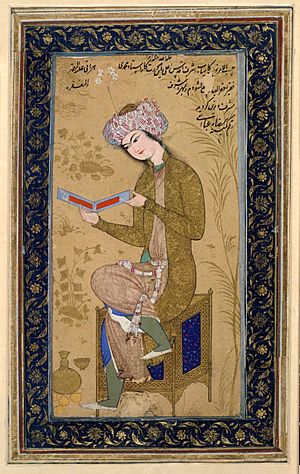Reza Abbasi facts for kids
Quick facts for kids
Reza Abbasi
رضا عباسی |
|
|---|---|

Posthumous portrait of Reza by his follower Mo'en Mosavver, 1673
|
|
| Born | 1565 |
| Died | 1635 Tabriz, Safavid Persia
|
| Occupation | Artist |
Reza Abbasi (also known as Riza yi-Abbasi or Reza-e Abbasi) was a very important Persian miniature painter. He lived from about 1565 to 1635. Reza Abbasi was the main artist of the Isfahan School during the later Safavid period in Persia.
He spent most of his career working for Shah Abbas I, a powerful ruler. Many people consider him the last great master of Persian miniature painting. He is most famous for his single miniature paintings. These were often put into special albums called muraqqas. He especially loved to paint beautiful young people.
Contents
Who Was Reza Abbasi?
Reza Abbasi was likely born in Kashan or Mashhad, cities in ancient Persia. His father, Ali Asghar, was also a miniature artist. Reza probably learned to paint from his father.
He joined the workshop of Shah Abbas I when he was quite young. At that time, the king's artists were making fewer illustrated books. Instead, they focused more on single paintings for albums.
How Did Reza Abbasi Sign His Art?
Unlike many artists from earlier times, Reza Abbasi often signed his work. He would also add dates and other details. This helps us know which paintings are truly his. His first known drawing with a date is from 1601.
He may have worked on a very large book called the Shahnameh. This book tells the epic stories of Persia. He also created 19 miniatures for a book called Khusraw and Shirin around 1631–32.
What Kind of Art Did He Create?
Reza Abbasi was best known for his single miniature paintings. These were made for private collectors to put in their muraqqa albums. His paintings often showed one or two people. The background was usually a simple garden, sometimes drawn in gold.
He made different kinds of art. Some were just pen drawings. Others were fully painted with many colors. Many of his works had some color in the figures, but not in the background. Later in his career, he used less color.
His favorite subjects were stylish and beautiful young men. His unique style influenced many Persian painters after him. His students included Mo'en Mosavver, who painted a portrait of Reza Abbasi many years later. Reza's son, Muhammed Shafi Abbasi, also became an artist.
Why Did His Name Change?
In his early career, Reza Abbasi signed his works as Aqa Risa. This can be confusing because another artist with a similar name worked in India at the same time.
In 1603, when he was about 38, the Shah gave him the special title Abbasi. This connected him to the Shah's own name. So, he became known as Reza Abbasi. Experts now agree that Aqa Risa and Reza Abbasi were the same person.
Reza Abbasi should not be confused with Ali Riza Abbasi. Ali Riza was the Shah's favorite calligrapher (someone who writes beautifully). He was in charge of the royal art workshop.
What Was His "Mid-Life Crisis"?
Around 1597 or 1598, Reza Abbasi moved with the Shah to the new capital city, Isfahan. Soon after, he left the Shah's service. It seems he wanted more freedom. He spent time with people from the "low-life" world of Isfahan, like athletes and wrestlers.
In 1610, he returned to the court. He probably needed money. He continued to work for the Shah until he died.
How Did His Style Change?
When Reza Abbasi returned to court, his painting style changed a lot. His early works used bright colors and showed great skill. But in the 1620s, he started using darker, earthier colors. His lines became thicker and heavier.
He began painting new subjects. These included older men, perhaps scholars or religious figures. He also painted birds and Europeans. In his final years, he sometimes made fun of the people he painted.
Where Can You See His Art Today?
Today, you can find Reza Abbasi's works in many places. In Tehran, Iran, there is a museum named after him, the Reza Abbasi Museum. You can also see his art in the Topkapı Palace in Istanbul, Turkey.
Many Western museums also have his paintings. These include the Freer Gallery of Art in the Smithsonian Institution, the British Museum, the Louvre in Paris, and the Metropolitan Museum of Art in New York.
Gallery
-
Prince Muhammad-Beik of Georgia by Reza Abbasi, 1620
-
Cup-bearer. Miniature
-
Musician dressed as a European with viol
See also
 In Spanish: Reza Abbasi para niños
In Spanish: Reza Abbasi para niños











